Response of Courts in Denying Claims Against the Police
VerifiedAdded on 2023/04/20
|11
|2891
|184
AI Summary
This article discusses the response of the courts in denying claims against the police and explores the circumstances in which a duty of care may be recognized. It includes case law examples and references to scholarly articles.
Contribute Materials
Your contribution can guide someone’s learning journey. Share your
documents today.
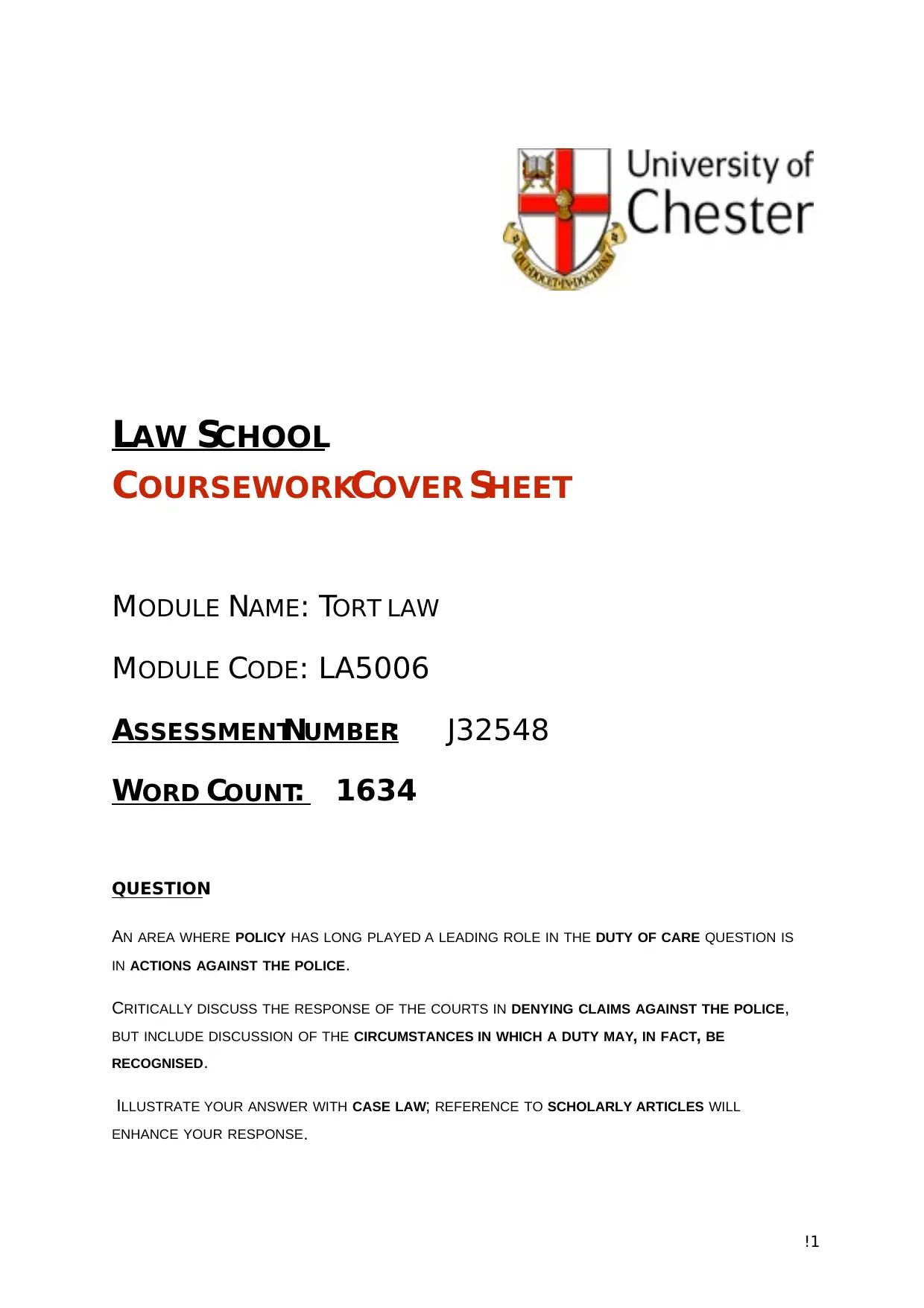
LAW SCHOOL
COURSEWORKCOVER SHEET
MODULE NAME: TORT LAW
MODULE CODE: LA5006
ASSESSMENTNUMBER: J32548
WORD COUNT: 1634
QUESTION
AN AREA WHERE POLICY HAS LONG PLAYED A LEADING ROLE IN THE DUTY OF CARE QUESTION IS
IN ACTIONS AGAINST THE POLICE.
CRITICALLY DISCUSS THE RESPONSE OF THE COURTS IN DENYING CLAIMS AGAINST THE POLICE,
BUT INCLUDE DISCUSSION OF THE CIRCUMSTANCES IN WHICH A DUTY MAY, IN FACT, BE
RECOGNISED.
ILLUSTRATE YOUR ANSWER WITH CASE LAW; REFERENCE TO SCHOLARLY ARTICLES WILL
ENHANCE YOUR RESPONSE.
!1
COURSEWORKCOVER SHEET
MODULE NAME: TORT LAW
MODULE CODE: LA5006
ASSESSMENTNUMBER: J32548
WORD COUNT: 1634
QUESTION
AN AREA WHERE POLICY HAS LONG PLAYED A LEADING ROLE IN THE DUTY OF CARE QUESTION IS
IN ACTIONS AGAINST THE POLICE.
CRITICALLY DISCUSS THE RESPONSE OF THE COURTS IN DENYING CLAIMS AGAINST THE POLICE,
BUT INCLUDE DISCUSSION OF THE CIRCUMSTANCES IN WHICH A DUTY MAY, IN FACT, BE
RECOGNISED.
ILLUSTRATE YOUR ANSWER WITH CASE LAW; REFERENCE TO SCHOLARLY ARTICLES WILL
ENHANCE YOUR RESPONSE.
!1
Secure Best Marks with AI Grader
Need help grading? Try our AI Grader for instant feedback on your assignments.
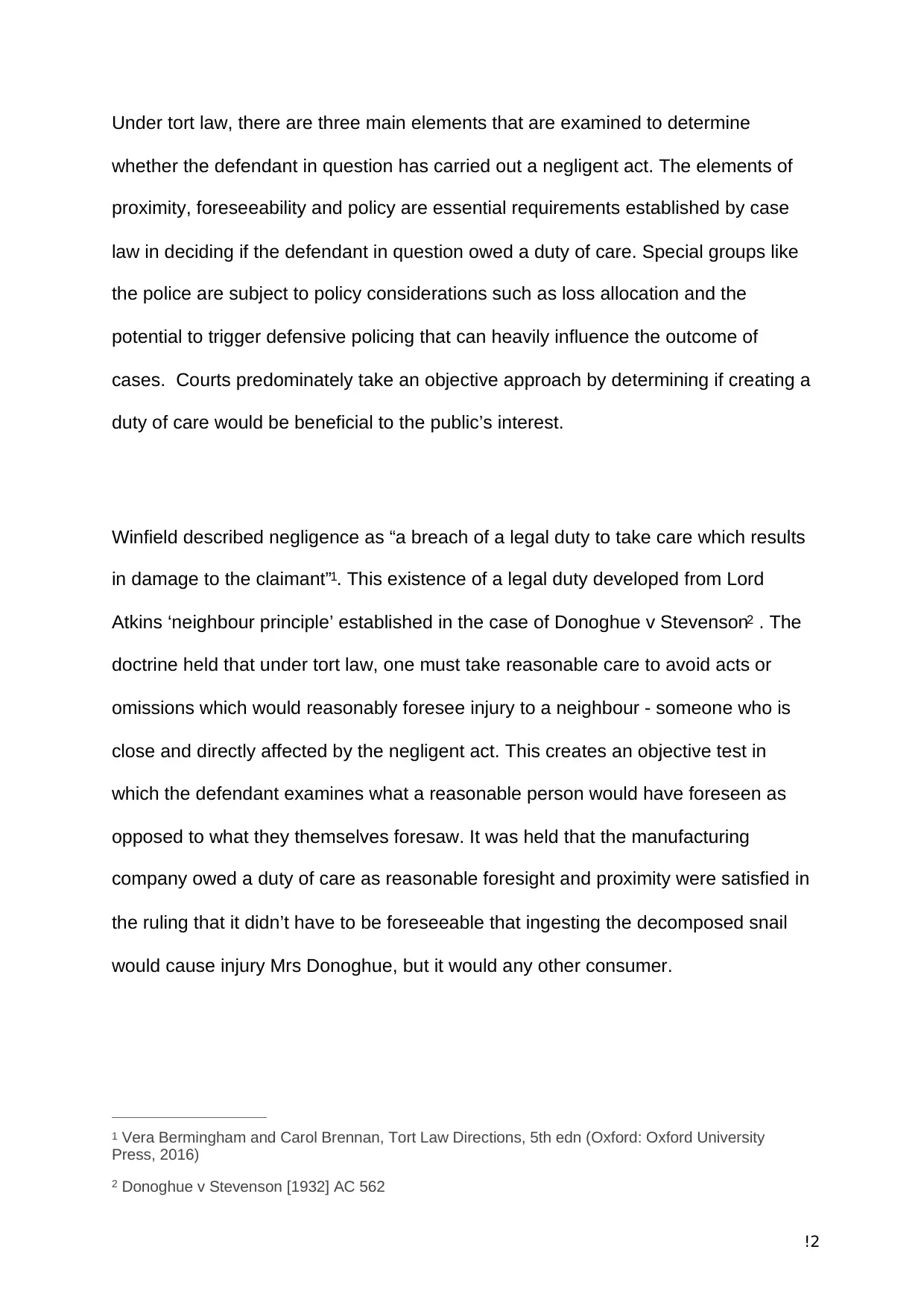
Under tort law, there are three main elements that are examined to determine
whether the defendant in question has carried out a negligent act. The elements of
proximity, foreseeability and policy are essential requirements established by case
law in deciding if the defendant in question owed a duty of care. Special groups like
the police are subject to policy considerations such as loss allocation and the
potential to trigger defensive policing that can heavily influence the outcome of
cases. Courts predominately take an objective approach by determining if creating a
duty of care would be beneficial to the public’s interest.
Winfield described negligence as “a breach of a legal duty to take care which results
in damage to the claimant” . This existence of a legal duty developed from Lord1
Atkins ‘neighbour principle’ established in the case of Donoghue v Stevenson . The2
doctrine held that under tort law, one must take reasonable care to avoid acts or
omissions which would reasonably foresee injury to a neighbour - someone who is
close and directly affected by the negligent act. This creates an objective test in
which the defendant examines what a reasonable person would have foreseen as
opposed to what they themselves foresaw. It was held that the manufacturing
company owed a duty of care as reasonable foresight and proximity were satisfied in
the ruling that it didn’t have to be foreseeable that ingesting the decomposed snail
would cause injury Mrs Donoghue, but it would any other consumer.
Vera Bermingham and Carol Brennan, Tort Law Directions, 5th edn (Oxford: Oxford University1
Press, 2016)
Donoghue v Stevenson [1932] AC 5622
!2
whether the defendant in question has carried out a negligent act. The elements of
proximity, foreseeability and policy are essential requirements established by case
law in deciding if the defendant in question owed a duty of care. Special groups like
the police are subject to policy considerations such as loss allocation and the
potential to trigger defensive policing that can heavily influence the outcome of
cases. Courts predominately take an objective approach by determining if creating a
duty of care would be beneficial to the public’s interest.
Winfield described negligence as “a breach of a legal duty to take care which results
in damage to the claimant” . This existence of a legal duty developed from Lord1
Atkins ‘neighbour principle’ established in the case of Donoghue v Stevenson . The2
doctrine held that under tort law, one must take reasonable care to avoid acts or
omissions which would reasonably foresee injury to a neighbour - someone who is
close and directly affected by the negligent act. This creates an objective test in
which the defendant examines what a reasonable person would have foreseen as
opposed to what they themselves foresaw. It was held that the manufacturing
company owed a duty of care as reasonable foresight and proximity were satisfied in
the ruling that it didn’t have to be foreseeable that ingesting the decomposed snail
would cause injury Mrs Donoghue, but it would any other consumer.
Vera Bermingham and Carol Brennan, Tort Law Directions, 5th edn (Oxford: Oxford University1
Press, 2016)
Donoghue v Stevenson [1932] AC 5622
!2
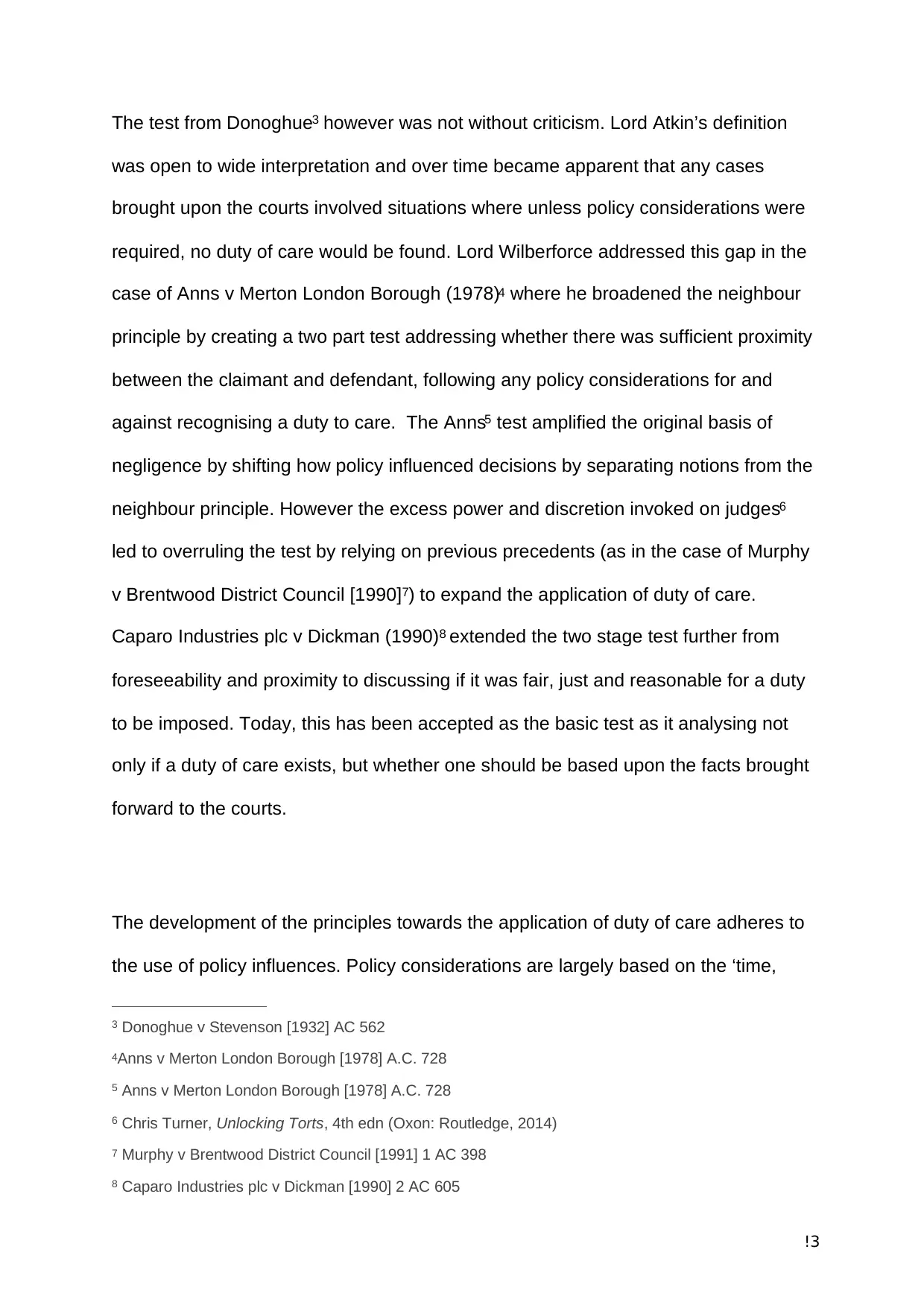
The test from Donoghue however was not without criticism. Lord Atkin’s definition3
was open to wide interpretation and over time became apparent that any cases
brought upon the courts involved situations where unless policy considerations were
required, no duty of care would be found. Lord Wilberforce addressed this gap in the
case of Anns v Merton London Borough (1978) where he broadened the neighbour4
principle by creating a two part test addressing whether there was sufficient proximity
between the claimant and defendant, following any policy considerations for and
against recognising a duty to care. The Anns test amplified the original basis of5
negligence by shifting how policy influenced decisions by separating notions from the
neighbour principle. However the excess power and discretion invoked on judges6
led to overruling the test by relying on previous precedents (as in the case of Murphy
v Brentwood District Council [1990] ) to expand the application of duty of care.7
Caparo Industries plc v Dickman (1990) extended the two stage test further from8
foreseeability and proximity to discussing if it was fair, just and reasonable for a duty
to be imposed. Today, this has been accepted as the basic test as it analysing not
only if a duty of care exists, but whether one should be based upon the facts brought
forward to the courts.
The development of the principles towards the application of duty of care adheres to
the use of policy influences. Policy considerations are largely based on the ‘time,
Donoghue v Stevenson [1932] AC 5623
Anns v Merton London Borough [1978] A.C. 7284
Anns v Merton London Borough [1978] A.C. 7285
Chris Turner, Unlocking Torts, 4th edn (Oxon: Routledge, 2014)6
Murphy v Brentwood District Council [1991] 1 AC 3987
Caparo Industries plc v Dickman [1990] 2 AC 6058
!3
was open to wide interpretation and over time became apparent that any cases
brought upon the courts involved situations where unless policy considerations were
required, no duty of care would be found. Lord Wilberforce addressed this gap in the
case of Anns v Merton London Borough (1978) where he broadened the neighbour4
principle by creating a two part test addressing whether there was sufficient proximity
between the claimant and defendant, following any policy considerations for and
against recognising a duty to care. The Anns test amplified the original basis of5
negligence by shifting how policy influenced decisions by separating notions from the
neighbour principle. However the excess power and discretion invoked on judges6
led to overruling the test by relying on previous precedents (as in the case of Murphy
v Brentwood District Council [1990] ) to expand the application of duty of care.7
Caparo Industries plc v Dickman (1990) extended the two stage test further from8
foreseeability and proximity to discussing if it was fair, just and reasonable for a duty
to be imposed. Today, this has been accepted as the basic test as it analysing not
only if a duty of care exists, but whether one should be based upon the facts brought
forward to the courts.
The development of the principles towards the application of duty of care adheres to
the use of policy influences. Policy considerations are largely based on the ‘time,
Donoghue v Stevenson [1932] AC 5623
Anns v Merton London Borough [1978] A.C. 7284
Anns v Merton London Borough [1978] A.C. 7285
Chris Turner, Unlocking Torts, 4th edn (Oxon: Routledge, 2014)6
Murphy v Brentwood District Council [1991] 1 AC 3987
Caparo Industries plc v Dickman [1990] 2 AC 6058
!3
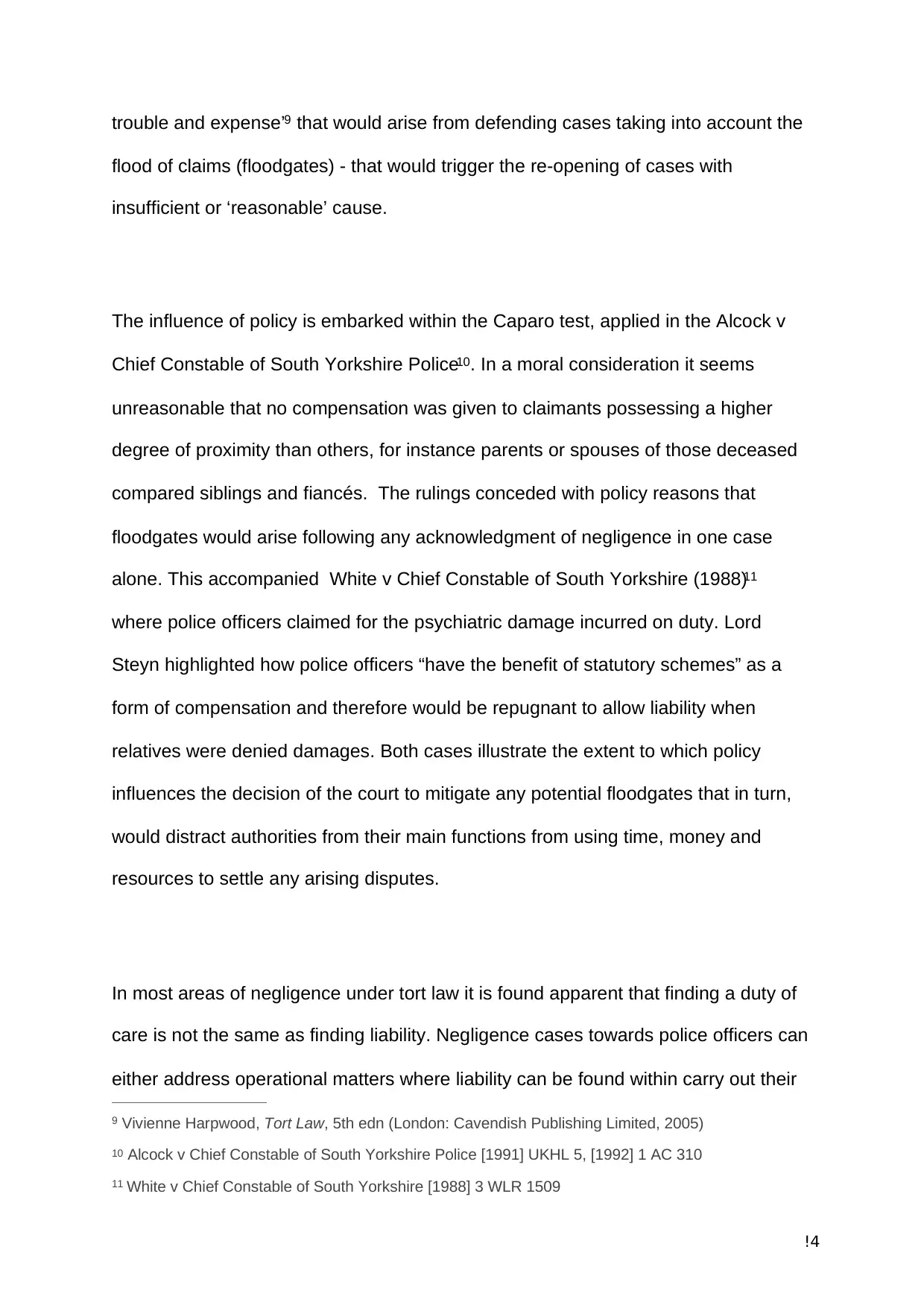
trouble and expense’ that would arise from defending cases taking into account the9
flood of claims (floodgates) - that would trigger the re-opening of cases with
insufficient or ‘reasonable’ cause.
The influence of policy is embarked within the Caparo test, applied in the Alcock v
Chief Constable of South Yorkshire Police . In a moral consideration it seems10
unreasonable that no compensation was given to claimants possessing a higher
degree of proximity than others, for instance parents or spouses of those deceased
compared siblings and fiancés. The rulings conceded with policy reasons that
floodgates would arise following any acknowledgment of negligence in one case
alone. This accompanied White v Chief Constable of South Yorkshire (1988)11
where police officers claimed for the psychiatric damage incurred on duty. Lord
Steyn highlighted how police officers “have the benefit of statutory schemes” as a
form of compensation and therefore would be repugnant to allow liability when
relatives were denied damages. Both cases illustrate the extent to which policy
influences the decision of the court to mitigate any potential floodgates that in turn,
would distract authorities from their main functions from using time, money and
resources to settle any arising disputes.
In most areas of negligence under tort law it is found apparent that finding a duty of
care is not the same as finding liability. Negligence cases towards police officers can
either address operational matters where liability can be found within carry out their
Vivienne Harpwood, Tort Law, 5th edn (London: Cavendish Publishing Limited, 2005)9
Alcock v Chief Constable of South Yorkshire Police [1991] UKHL 5, [1992] 1 AC 31010
White v Chief Constable of South Yorkshire [1988] 3 WLR 150911
!4
flood of claims (floodgates) - that would trigger the re-opening of cases with
insufficient or ‘reasonable’ cause.
The influence of policy is embarked within the Caparo test, applied in the Alcock v
Chief Constable of South Yorkshire Police . In a moral consideration it seems10
unreasonable that no compensation was given to claimants possessing a higher
degree of proximity than others, for instance parents or spouses of those deceased
compared siblings and fiancés. The rulings conceded with policy reasons that
floodgates would arise following any acknowledgment of negligence in one case
alone. This accompanied White v Chief Constable of South Yorkshire (1988)11
where police officers claimed for the psychiatric damage incurred on duty. Lord
Steyn highlighted how police officers “have the benefit of statutory schemes” as a
form of compensation and therefore would be repugnant to allow liability when
relatives were denied damages. Both cases illustrate the extent to which policy
influences the decision of the court to mitigate any potential floodgates that in turn,
would distract authorities from their main functions from using time, money and
resources to settle any arising disputes.
In most areas of negligence under tort law it is found apparent that finding a duty of
care is not the same as finding liability. Negligence cases towards police officers can
either address operational matters where liability can be found within carry out their
Vivienne Harpwood, Tort Law, 5th edn (London: Cavendish Publishing Limited, 2005)9
Alcock v Chief Constable of South Yorkshire Police [1991] UKHL 5, [1992] 1 AC 31010
White v Chief Constable of South Yorkshire [1988] 3 WLR 150911
!4
Secure Best Marks with AI Grader
Need help grading? Try our AI Grader for instant feedback on your assignments.
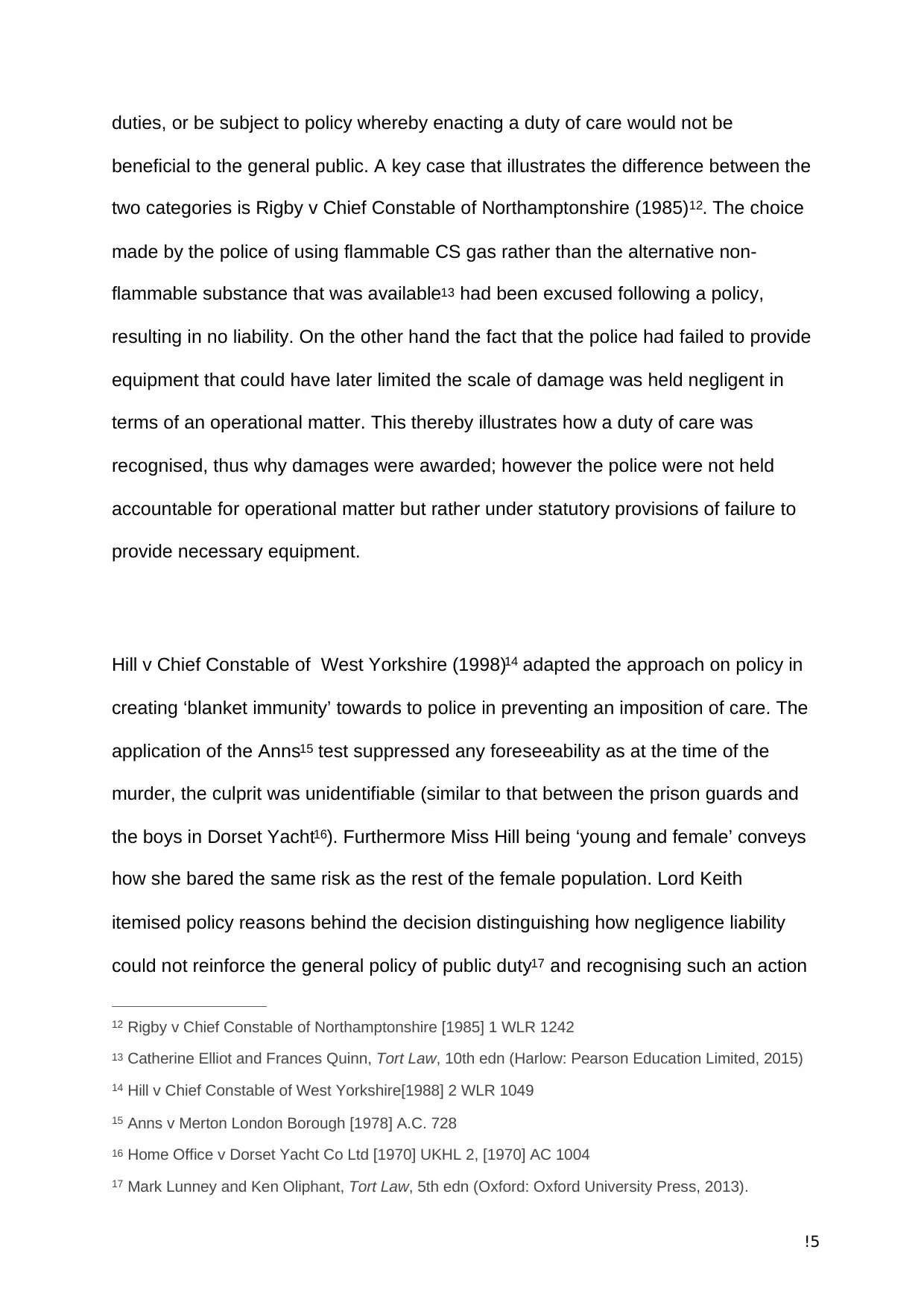
duties, or be subject to policy whereby enacting a duty of care would not be
beneficial to the general public. A key case that illustrates the difference between the
two categories is Rigby v Chief Constable of Northamptonshire (1985) . The choice12
made by the police of using flammable CS gas rather than the alternative non-
flammable substance that was available had been excused following a policy,13
resulting in no liability. On the other hand the fact that the police had failed to provide
equipment that could have later limited the scale of damage was held negligent in
terms of an operational matter. This thereby illustrates how a duty of care was
recognised, thus why damages were awarded; however the police were not held
accountable for operational matter but rather under statutory provisions of failure to
provide necessary equipment.
Hill v Chief Constable of West Yorkshire (1998) adapted the approach on policy in14
creating ‘blanket immunity’ towards to police in preventing an imposition of care. The
application of the Anns test suppressed any foreseeability as at the time of the15
murder, the culprit was unidentifiable (similar to that between the prison guards and
the boys in Dorset Yacht ). Furthermore Miss Hill being ‘young and female’ conveys16
how she bared the same risk as the rest of the female population. Lord Keith
itemised policy reasons behind the decision distinguishing how negligence liability
could not reinforce the general policy of public duty and recognising such an action17
Rigby v Chief Constable of Northamptonshire [1985] 1 WLR 124212
Catherine Elliot and Frances Quinn, Tort Law, 10th edn (Harlow: Pearson Education Limited, 2015)13
Hill v Chief Constable of West Yorkshire[1988] 2 WLR 104914
Anns v Merton London Borough [1978] A.C. 72815
Home Office v Dorset Yacht Co Ltd [1970] UKHL 2, [1970] AC 100416
Mark Lunney and Ken Oliphant, Tort Law, 5th edn (Oxford: Oxford University Press, 2013).17
!5
beneficial to the general public. A key case that illustrates the difference between the
two categories is Rigby v Chief Constable of Northamptonshire (1985) . The choice12
made by the police of using flammable CS gas rather than the alternative non-
flammable substance that was available had been excused following a policy,13
resulting in no liability. On the other hand the fact that the police had failed to provide
equipment that could have later limited the scale of damage was held negligent in
terms of an operational matter. This thereby illustrates how a duty of care was
recognised, thus why damages were awarded; however the police were not held
accountable for operational matter but rather under statutory provisions of failure to
provide necessary equipment.
Hill v Chief Constable of West Yorkshire (1998) adapted the approach on policy in14
creating ‘blanket immunity’ towards to police in preventing an imposition of care. The
application of the Anns test suppressed any foreseeability as at the time of the15
murder, the culprit was unidentifiable (similar to that between the prison guards and
the boys in Dorset Yacht ). Furthermore Miss Hill being ‘young and female’ conveys16
how she bared the same risk as the rest of the female population. Lord Keith
itemised policy reasons behind the decision distinguishing how negligence liability
could not reinforce the general policy of public duty and recognising such an action17
Rigby v Chief Constable of Northamptonshire [1985] 1 WLR 124212
Catherine Elliot and Frances Quinn, Tort Law, 10th edn (Harlow: Pearson Education Limited, 2015)13
Hill v Chief Constable of West Yorkshire[1988] 2 WLR 104914
Anns v Merton London Borough [1978] A.C. 72815
Home Office v Dorset Yacht Co Ltd [1970] UKHL 2, [1970] AC 100416
Mark Lunney and Ken Oliphant, Tort Law, 5th edn (Oxford: Oxford University Press, 2013).17
!5
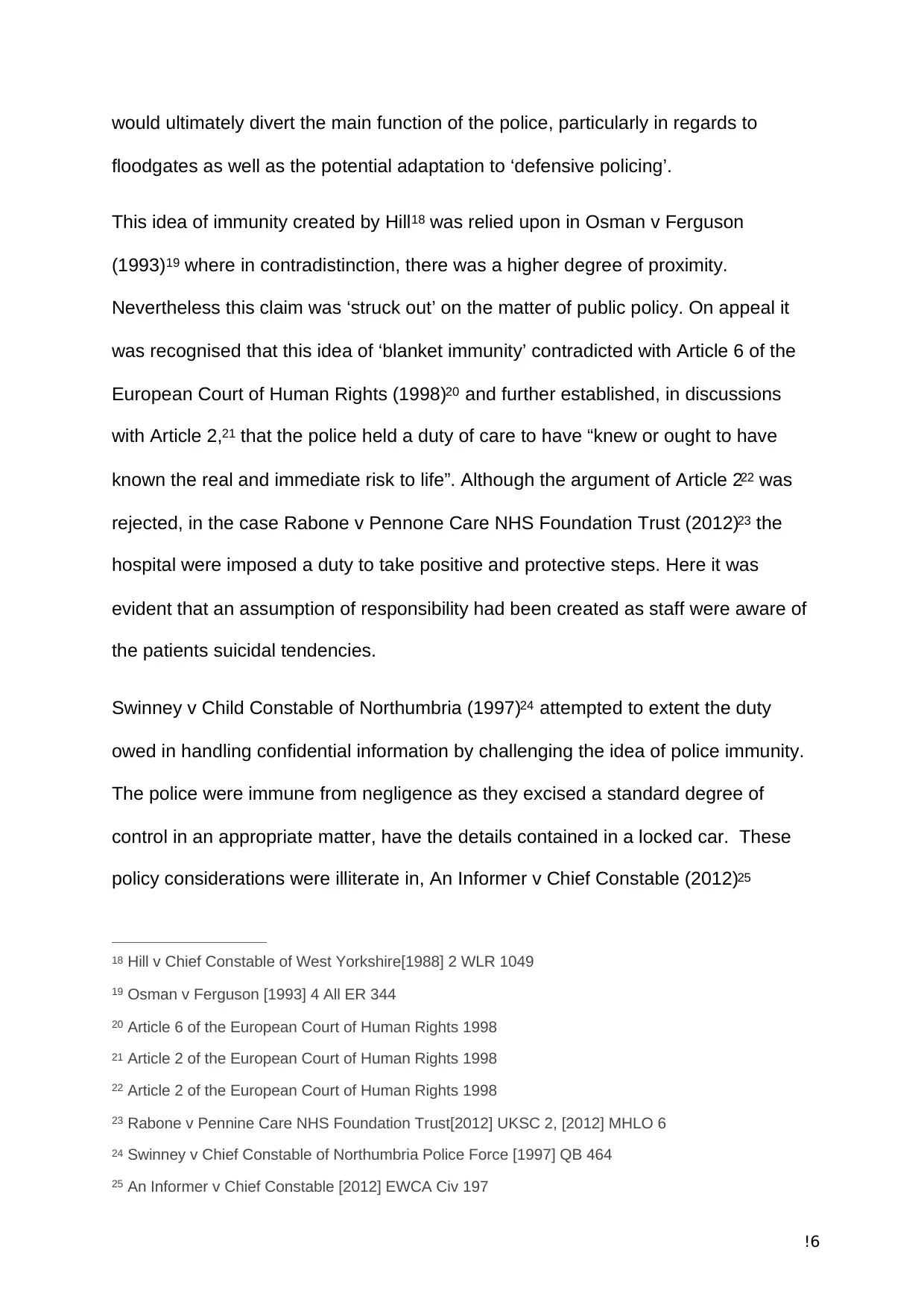
would ultimately divert the main function of the police, particularly in regards to
floodgates as well as the potential adaptation to ‘defensive policing’.
This idea of immunity created by Hill was relied upon in Osman v Ferguson18
(1993) where in contradistinction, there was a higher degree of proximity.19
Nevertheless this claim was ‘struck out’ on the matter of public policy. On appeal it
was recognised that this idea of ‘blanket immunity’ contradicted with Article 6 of the
European Court of Human Rights (1998) and further established, in discussions20
with Article 2, that the police held a duty of care to have “knew or ought to have21
known the real and immediate risk to life”. Although the argument of Article 2 was22
rejected, in the case Rabone v Pennone Care NHS Foundation Trust (2012) the23
hospital were imposed a duty to take positive and protective steps. Here it was
evident that an assumption of responsibility had been created as staff were aware of
the patients suicidal tendencies.
Swinney v Child Constable of Northumbria (1997) attempted to extent the duty24
owed in handling confidential information by challenging the idea of police immunity.
The police were immune from negligence as they excised a standard degree of
control in an appropriate matter, have the details contained in a locked car. These
policy considerations were illiterate in, An Informer v Chief Constable (2012)25
Hill v Chief Constable of West Yorkshire[1988] 2 WLR 104918
Osman v Ferguson [1993] 4 All ER 34419
Article 6 of the European Court of Human Rights 199820
Article 2 of the European Court of Human Rights 199821
Article 2 of the European Court of Human Rights 199822
Rabone v Pennine Care NHS Foundation Trust[2012] UKSC 2, [2012] MHLO 623
Swinney v Chief Constable of Northumbria Police Force [1997] QB 46424
An Informer v Chief Constable [2012] EWCA Civ 19725
!6
floodgates as well as the potential adaptation to ‘defensive policing’.
This idea of immunity created by Hill was relied upon in Osman v Ferguson18
(1993) where in contradistinction, there was a higher degree of proximity.19
Nevertheless this claim was ‘struck out’ on the matter of public policy. On appeal it
was recognised that this idea of ‘blanket immunity’ contradicted with Article 6 of the
European Court of Human Rights (1998) and further established, in discussions20
with Article 2, that the police held a duty of care to have “knew or ought to have21
known the real and immediate risk to life”. Although the argument of Article 2 was22
rejected, in the case Rabone v Pennone Care NHS Foundation Trust (2012) the23
hospital were imposed a duty to take positive and protective steps. Here it was
evident that an assumption of responsibility had been created as staff were aware of
the patients suicidal tendencies.
Swinney v Child Constable of Northumbria (1997) attempted to extent the duty24
owed in handling confidential information by challenging the idea of police immunity.
The police were immune from negligence as they excised a standard degree of
control in an appropriate matter, have the details contained in a locked car. These
policy considerations were illiterate in, An Informer v Chief Constable (2012)25
Hill v Chief Constable of West Yorkshire[1988] 2 WLR 104918
Osman v Ferguson [1993] 4 All ER 34419
Article 6 of the European Court of Human Rights 199820
Article 2 of the European Court of Human Rights 199821
Article 2 of the European Court of Human Rights 199822
Rabone v Pennine Care NHS Foundation Trust[2012] UKSC 2, [2012] MHLO 623
Swinney v Chief Constable of Northumbria Police Force [1997] QB 46424
An Informer v Chief Constable [2012] EWCA Civ 19725
!6
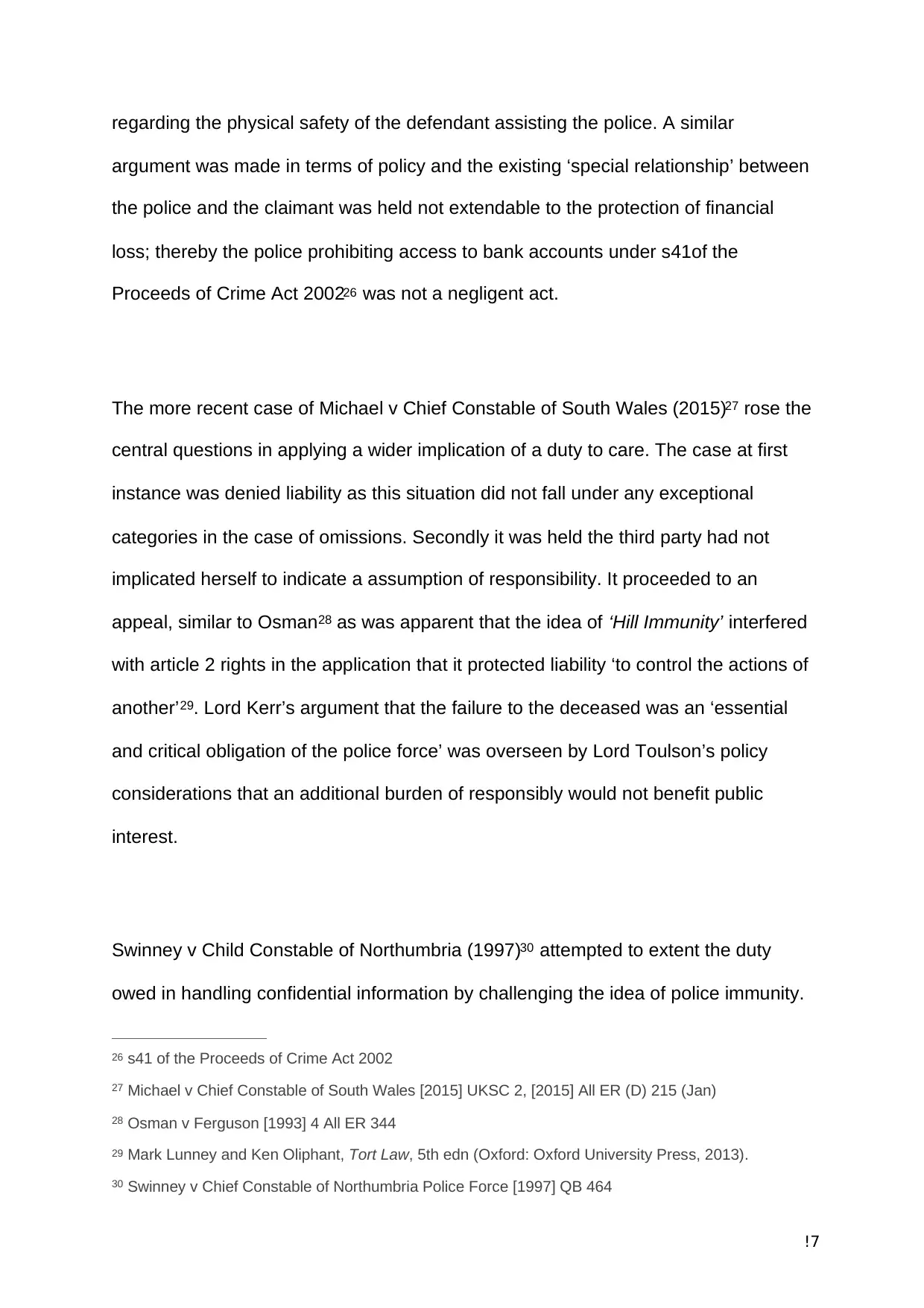
regarding the physical safety of the defendant assisting the police. A similar
argument was made in terms of policy and the existing ‘special relationship’ between
the police and the claimant was held not extendable to the protection of financial
loss; thereby the police prohibiting access to bank accounts under s41of the
Proceeds of Crime Act 2002 was not a negligent act.26
The more recent case of Michael v Chief Constable of South Wales (2015) rose the27
central questions in applying a wider implication of a duty to care. The case at first
instance was denied liability as this situation did not fall under any exceptional
categories in the case of omissions. Secondly it was held the third party had not
implicated herself to indicate a assumption of responsibility. It proceeded to an
appeal, similar to Osman as was apparent that the idea of ‘Hill Immunity’ interfered28
with article 2 rights in the application that it protected liability ‘to control the actions of
another’ . Lord Kerr’s argument that the failure to the deceased was an ‘essential29
and critical obligation of the police force’ was overseen by Lord Toulson’s policy
considerations that an additional burden of responsibly would not benefit public
interest.
Swinney v Child Constable of Northumbria (1997) attempted to extent the duty30
owed in handling confidential information by challenging the idea of police immunity.
s41 of the Proceeds of Crime Act 200226
Michael v Chief Constable of South Wales [2015] UKSC 2, [2015] All ER (D) 215 (Jan)27
Osman v Ferguson [1993] 4 All ER 34428
Mark Lunney and Ken Oliphant, Tort Law, 5th edn (Oxford: Oxford University Press, 2013).29
Swinney v Chief Constable of Northumbria Police Force [1997] QB 46430
!7
argument was made in terms of policy and the existing ‘special relationship’ between
the police and the claimant was held not extendable to the protection of financial
loss; thereby the police prohibiting access to bank accounts under s41of the
Proceeds of Crime Act 2002 was not a negligent act.26
The more recent case of Michael v Chief Constable of South Wales (2015) rose the27
central questions in applying a wider implication of a duty to care. The case at first
instance was denied liability as this situation did not fall under any exceptional
categories in the case of omissions. Secondly it was held the third party had not
implicated herself to indicate a assumption of responsibility. It proceeded to an
appeal, similar to Osman as was apparent that the idea of ‘Hill Immunity’ interfered28
with article 2 rights in the application that it protected liability ‘to control the actions of
another’ . Lord Kerr’s argument that the failure to the deceased was an ‘essential29
and critical obligation of the police force’ was overseen by Lord Toulson’s policy
considerations that an additional burden of responsibly would not benefit public
interest.
Swinney v Child Constable of Northumbria (1997) attempted to extent the duty30
owed in handling confidential information by challenging the idea of police immunity.
s41 of the Proceeds of Crime Act 200226
Michael v Chief Constable of South Wales [2015] UKSC 2, [2015] All ER (D) 215 (Jan)27
Osman v Ferguson [1993] 4 All ER 34428
Mark Lunney and Ken Oliphant, Tort Law, 5th edn (Oxford: Oxford University Press, 2013).29
Swinney v Chief Constable of Northumbria Police Force [1997] QB 46430
!7
Paraphrase This Document
Need a fresh take? Get an instant paraphrase of this document with our AI Paraphraser
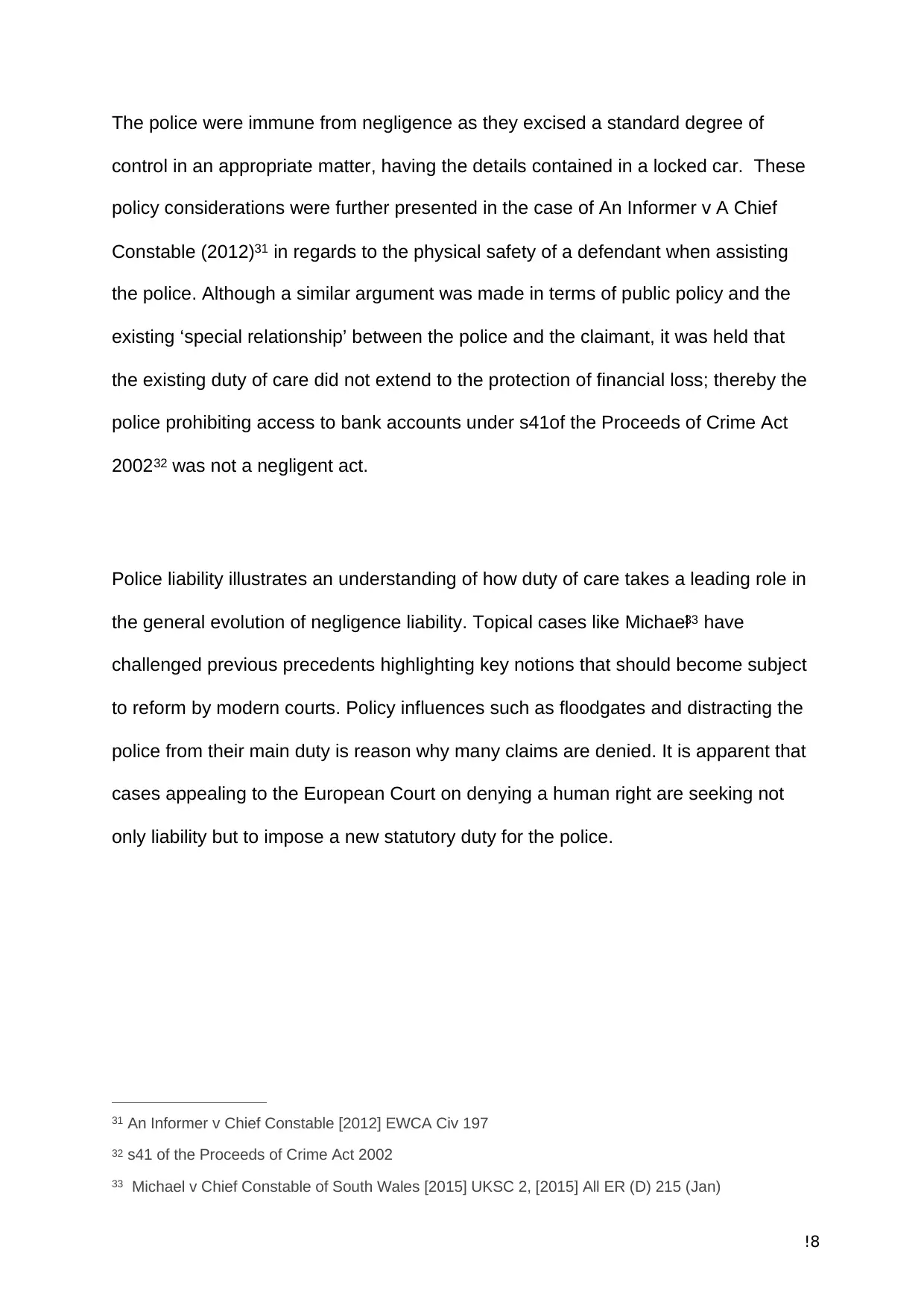
The police were immune from negligence as they excised a standard degree of
control in an appropriate matter, having the details contained in a locked car. These
policy considerations were further presented in the case of An Informer v A Chief
Constable (2012) in regards to the physical safety of a defendant when assisting31
the police. Although a similar argument was made in terms of public policy and the
existing ‘special relationship’ between the police and the claimant, it was held that
the existing duty of care did not extend to the protection of financial loss; thereby the
police prohibiting access to bank accounts under s41of the Proceeds of Crime Act
2002 was not a negligent act.32
Police liability illustrates an understanding of how duty of care takes a leading role in
the general evolution of negligence liability. Topical cases like Michael have33
challenged previous precedents highlighting key notions that should become subject
to reform by modern courts. Policy influences such as floodgates and distracting the
police from their main duty is reason why many claims are denied. It is apparent that
cases appealing to the European Court on denying a human right are seeking not
only liability but to impose a new statutory duty for the police.
An Informer v Chief Constable [2012] EWCA Civ 19731
s41 of the Proceeds of Crime Act 200232
Michael v Chief Constable of South Wales [2015] UKSC 2, [2015] All ER (D) 215 (Jan)33
!8
control in an appropriate matter, having the details contained in a locked car. These
policy considerations were further presented in the case of An Informer v A Chief
Constable (2012) in regards to the physical safety of a defendant when assisting31
the police. Although a similar argument was made in terms of public policy and the
existing ‘special relationship’ between the police and the claimant, it was held that
the existing duty of care did not extend to the protection of financial loss; thereby the
police prohibiting access to bank accounts under s41of the Proceeds of Crime Act
2002 was not a negligent act.32
Police liability illustrates an understanding of how duty of care takes a leading role in
the general evolution of negligence liability. Topical cases like Michael have33
challenged previous precedents highlighting key notions that should become subject
to reform by modern courts. Policy influences such as floodgates and distracting the
police from their main duty is reason why many claims are denied. It is apparent that
cases appealing to the European Court on denying a human right are seeking not
only liability but to impose a new statutory duty for the police.
An Informer v Chief Constable [2012] EWCA Civ 19731
s41 of the Proceeds of Crime Act 200232
Michael v Chief Constable of South Wales [2015] UKSC 2, [2015] All ER (D) 215 (Jan)33
!8
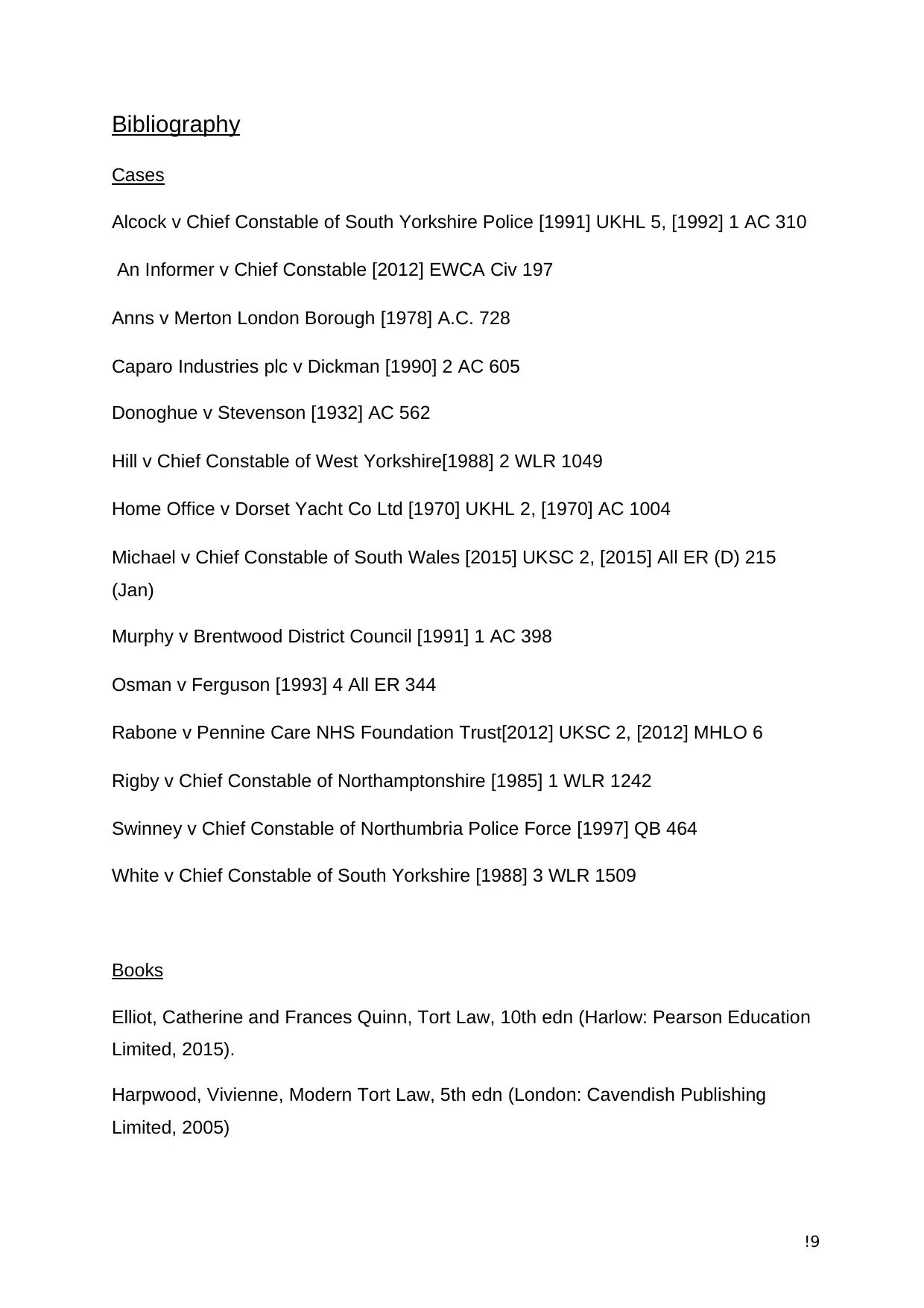
Bibliography
Cases
Alcock v Chief Constable of South Yorkshire Police [1991] UKHL 5, [1992] 1 AC 310
An Informer v Chief Constable [2012] EWCA Civ 197
Anns v Merton London Borough [1978] A.C. 728
Caparo Industries plc v Dickman [1990] 2 AC 605
Donoghue v Stevenson [1932] AC 562
Hill v Chief Constable of West Yorkshire[1988] 2 WLR 1049
Home Office v Dorset Yacht Co Ltd [1970] UKHL 2, [1970] AC 1004
Michael v Chief Constable of South Wales [2015] UKSC 2, [2015] All ER (D) 215
(Jan)
Murphy v Brentwood District Council [1991] 1 AC 398
Osman v Ferguson [1993] 4 All ER 344
Rabone v Pennine Care NHS Foundation Trust[2012] UKSC 2, [2012] MHLO 6
Rigby v Chief Constable of Northamptonshire [1985] 1 WLR 1242
Swinney v Chief Constable of Northumbria Police Force [1997] QB 464
White v Chief Constable of South Yorkshire [1988] 3 WLR 1509
Books
Elliot, Catherine and Frances Quinn, Tort Law, 10th edn (Harlow: Pearson Education
Limited, 2015).
Harpwood, Vivienne, Modern Tort Law, 5th edn (London: Cavendish Publishing
Limited, 2005)
!9
Cases
Alcock v Chief Constable of South Yorkshire Police [1991] UKHL 5, [1992] 1 AC 310
An Informer v Chief Constable [2012] EWCA Civ 197
Anns v Merton London Borough [1978] A.C. 728
Caparo Industries plc v Dickman [1990] 2 AC 605
Donoghue v Stevenson [1932] AC 562
Hill v Chief Constable of West Yorkshire[1988] 2 WLR 1049
Home Office v Dorset Yacht Co Ltd [1970] UKHL 2, [1970] AC 1004
Michael v Chief Constable of South Wales [2015] UKSC 2, [2015] All ER (D) 215
(Jan)
Murphy v Brentwood District Council [1991] 1 AC 398
Osman v Ferguson [1993] 4 All ER 344
Rabone v Pennine Care NHS Foundation Trust[2012] UKSC 2, [2012] MHLO 6
Rigby v Chief Constable of Northamptonshire [1985] 1 WLR 1242
Swinney v Chief Constable of Northumbria Police Force [1997] QB 464
White v Chief Constable of South Yorkshire [1988] 3 WLR 1509
Books
Elliot, Catherine and Frances Quinn, Tort Law, 10th edn (Harlow: Pearson Education
Limited, 2015).
Harpwood, Vivienne, Modern Tort Law, 5th edn (London: Cavendish Publishing
Limited, 2005)
!9
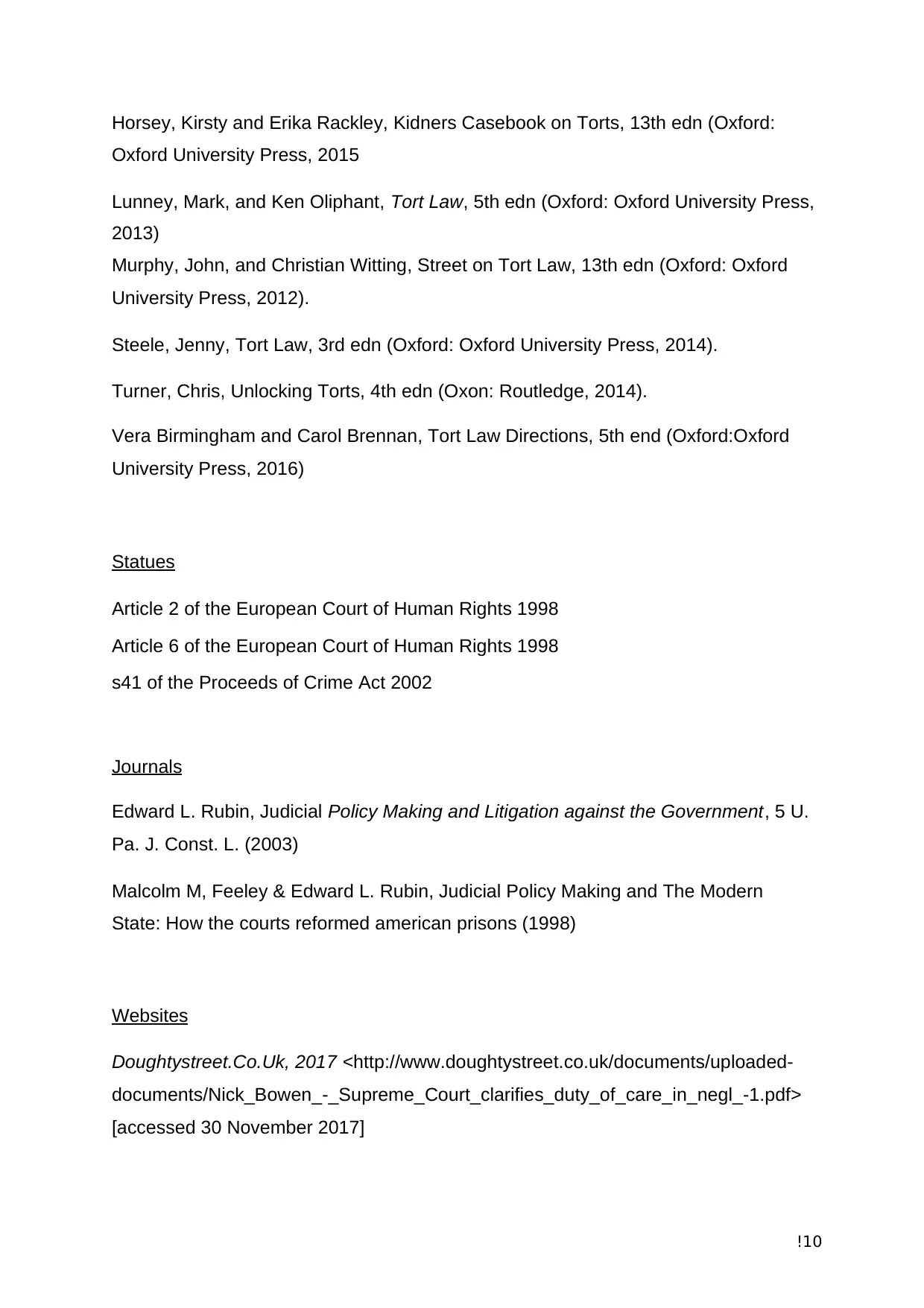
Horsey, Kirsty and Erika Rackley, Kidners Casebook on Torts, 13th edn (Oxford:
Oxford University Press, 2015
Lunney, Mark, and Ken Oliphant, Tort Law, 5th edn (Oxford: Oxford University Press,
2013)
Murphy, John, and Christian Witting, Street on Tort Law, 13th edn (Oxford: Oxford
University Press, 2012).
Steele, Jenny, Tort Law, 3rd edn (Oxford: Oxford University Press, 2014).
Turner, Chris, Unlocking Torts, 4th edn (Oxon: Routledge, 2014).
Vera Birmingham and Carol Brennan, Tort Law Directions, 5th end (Oxford:Oxford
University Press, 2016)
Statues
Article 2 of the European Court of Human Rights 1998
Article 6 of the European Court of Human Rights 1998
s41 of the Proceeds of Crime Act 2002
Journals
Edward L. Rubin, Judicial Policy Making and Litigation against the Government, 5 U.
Pa. J. Const. L. (2003)
Malcolm M, Feeley & Edward L. Rubin, Judicial Policy Making and The Modern
State: How the courts reformed american prisons (1998)
Websites
Doughtystreet.Co.Uk, 2017 <http://www.doughtystreet.co.uk/documents/uploaded-
documents/Nick_Bowen_-_Supreme_Court_clarifies_duty_of_care_in_negl_-1.pdf>
[accessed 30 November 2017]
!10
Oxford University Press, 2015
Lunney, Mark, and Ken Oliphant, Tort Law, 5th edn (Oxford: Oxford University Press,
2013)
Murphy, John, and Christian Witting, Street on Tort Law, 13th edn (Oxford: Oxford
University Press, 2012).
Steele, Jenny, Tort Law, 3rd edn (Oxford: Oxford University Press, 2014).
Turner, Chris, Unlocking Torts, 4th edn (Oxon: Routledge, 2014).
Vera Birmingham and Carol Brennan, Tort Law Directions, 5th end (Oxford:Oxford
University Press, 2016)
Statues
Article 2 of the European Court of Human Rights 1998
Article 6 of the European Court of Human Rights 1998
s41 of the Proceeds of Crime Act 2002
Journals
Edward L. Rubin, Judicial Policy Making and Litigation against the Government, 5 U.
Pa. J. Const. L. (2003)
Malcolm M, Feeley & Edward L. Rubin, Judicial Policy Making and The Modern
State: How the courts reformed american prisons (1998)
Websites
Doughtystreet.Co.Uk, 2017 <http://www.doughtystreet.co.uk/documents/uploaded-
documents/Nick_Bowen_-_Supreme_Court_clarifies_duty_of_care_in_negl_-1.pdf>
[accessed 30 November 2017]
!10
Secure Best Marks with AI Grader
Need help grading? Try our AI Grader for instant feedback on your assignments.

http://www.mentalhealthlaw.co.uk
Rabone_v_Pennine_Care_NHS_Foundation_Trust_(2012)_UKSC_2,_(2012)_MHL
O_6
http://www.pointoflaw.com/archives/2013/03/floods-of-floodgates.php
!11
Rabone_v_Pennine_Care_NHS_Foundation_Trust_(2012)_UKSC_2,_(2012)_MHL
O_6
http://www.pointoflaw.com/archives/2013/03/floods-of-floodgates.php
!11
1 out of 11
Related Documents
Your All-in-One AI-Powered Toolkit for Academic Success.
+13062052269
info@desklib.com
Available 24*7 on WhatsApp / Email
![[object Object]](/_next/static/media/star-bottom.7253800d.svg)
Unlock your academic potential
© 2024 | Zucol Services PVT LTD | All rights reserved.




